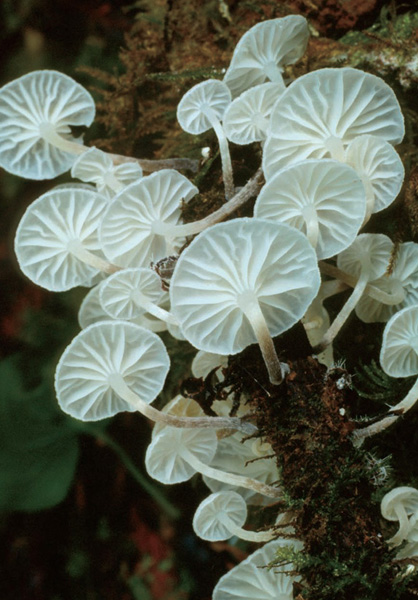

MUSHROOMS
of the PACIFIC NORTHWEST
Steve Trudell & Joe Ammirati
Illustrations by MARSHA MELLO

To the memories of Ben Woo, Kit Scates Barnhart, and Dan Stuntz, for their many contributions to mushrooming in the Pacific Northwest
Copyright 2009 by Steve Trudell and Joe Ammirati. All rights reserved.
Except as noted otherwise, all photographs are by Steve Trudell.
FRONT ENDPAPERS: Shortcut visual key to the major groups of mushrooms featured in this guide. Color codes on page 5 will guide you quickly to the appropriate section of the mushroom accounts; for a more detailed approach, see the text-based key that begins on page 38. Back endpapers: On the left, life cycle of a gilled mushroom (Amanita phalloides, the death cap); on the right, parts of a mushroom (for additional definitions and illustrations, see the Glossary). These and all other illustrations are by Marsha Mello.
HALF TITLE PAGE: Stropharia ambigua; frontis-piece: Mycena haematopus; this page: Laetiporus conifericola; page 6: Marasmiellus candidus; page 10: Hypholoma fasciculare; page 36: Parasola plicatilis.
NOTE: The authors and the publisher disclaim any liability whatsoever with respect to any losses or damages arising out of the use of the information contained in this book.
Published in 2009 by Timber Press, Inc.
The Haseltine Building
133 S.W. Second Avenue, Suite 450
Portland, Oregon 97204-3527
www.timberpress.com
2 The Quadrant
135 Salusbury Road
London NW6 6RJ
www.timberpress.co.uk
Printed in China
Designed by Susan Applegate
Second printing 2010
ISBN-13: 978-0-88192-935-5
Catalog records for this book are available from the Library of Congress and the British Library.

CONTENTS















PREFACE
Generally speaking, the Pacific Northwest (PNW) encompasses all of Oregon, Idaho, and Washington, plus portions of northern California, western Montana, southern Alaska, and southern British Columbia (B.C.), Canada. The most characteristic part of the PNW biological region, however, lies north of a line that roughly coincides with the 44th parallel of latitude, extending eastward from Florence to Springfield/Eugene to Bend to Ontario, Oregon, and then through Boise to Idaho Falls, Idaho. The northern limit is in southern B.C. and Alaska at the transition to the boreal forest region. For most people, the PNW evokes images of towering trees festooned with lichens and clubmosses, dripping from the seemingly incessant rain. However, this picture is not complete without an assortment of mushrooms decorating the forest floor for anyone who takes time to look down.
Mushrooms, as we broadly define them, represent numerous small to large, conspicuous fungi that have evolved an array of different forms and colors. They occur as decomposers, living on dead organic materials, and as symbionts with plants, animals, and other fungi. Because of these lifestyles, mushrooms play major roles in the functioning of ecosystems where they provide nutrients to trees and other plants, recycle those nutrients by breaking down wood and other plant materials, and cause damage as plant pathogens. Many species have intercontinental distributions across the Northern Hemisphere, others occur at the continental or regional scale, a smaller number are more localized, and some have global distributions. Where fungus species occur today reflects a complex of interactions with other organisms and the physical environment over time. Temperature, moisture, soil, topography, vegetation, and other factors influence where fungi grow, when they produce their fruitbodies, and how their spores are dispersed from one location to another.
People from many cultures have long histories of gathering mushrooms for food, medicine, and mind-altering effects and, in the process, have accumulated considerable knowledge about poisonous and deadly species. In addition, mushrooms have been used for a variety of other purposes, including tinder, dyes, clothing, and decoration in the form of illustrations, carvings, and icons. The use of mushrooms by peoples in diverse cultures invariably has involved some system of names to facilitate acquiring and exchanging information about them. While almost all cultures have developed a system of common names for their most notable edible and poisonous mushrooms, none have assigned names to all mushrooms, so the overwhelming majority have no common names. Beginning around the late 1700s, mushrooms began to be studied, given scientific names, and arranged in classification schemes. That activity continues today, and gradually many fungi for which there were no previous names have been given scientific names. For identification purposes, it is better to use these names so that communication within and across cultures and societies is as precise and effective as possible.
Mushroom-hunting has always had a certain number of devotees, but it has become increasingly popular over the past 50 or so years, partly in response to the wide variety of high-quality books and other resources now available for mushroom identification. However, surprisingly, few of these resources were developed specifically for the PNW. Mushroom books and field guides for North America first appeared around 1900. Some of the better known early works include Our Edible Toadstools and Mushrooms (W. H. Gibson 1895),
Next page
























